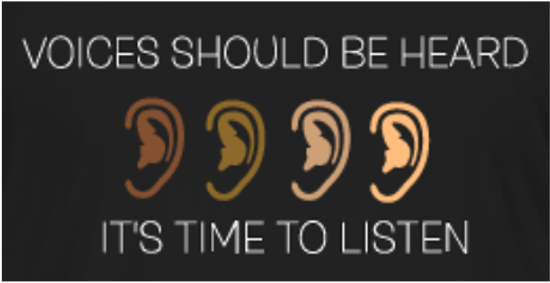WSSLHA Black History Month Seminar
- WSSLHA Wayne State University
- Feb 19, 2021
- 4 min read
WSSLHA and WSU Student Academy of Audiology hosted a Black History Month Seminar on Thursday, February 18, 2021 at 7:30 PM

Language Differences - African American English Dialect (AAE)
WSSLHA Representatives presented on the language differences between Standard American English (SAE) and African American English (AAE).
A language difference is defined as a language that has its own grammatical structure, accent, and/or vocabulary and is deviated from SAE. People who speak different dialects should be able to understand one another. AAE is a rule-governed dialect also known as Black English, Ebonics, nonstandard English and Black English Vernacular. There are many misconceptions associated with speakers of AAE including, intellectual delay/disorder, language delay/disorder, poor English, slang, etc.
Language differences should not be confused with language disorders, which is defined as the impaired use and/or comprehension of spoken/written/signed language. As clinicians, we need to be competent in cultural language differences in order to properly diagnose culturally-linguistically diverse clients. Because not every African American speaks in AAE, clinicians need to be culturally and linguistically sensitive without holding judgment and assumptions.
Common Dialectal Difference in AAE vs. SAE
Initial "Th" sound -> /d/ ("Them" -> "Dem")
Final "Th" sound -> /f/ ("Mouth" -> "Mouf")
Deletion of medial and final /r/ sounds ("Alright" -> "Aight")
Copula deletion of verbs and variants ("He is a hard worker" -> "He a hard worker")
Use of multiple negations ("She ain't got no money for nobody")
Deletion of possessive "-s" or "-'s" ("The shoes are Tina's" -> "Da shoe are Tina")
Historical Perspective on American Sign Language (ASL) and Black ASL
The SAA presented on Black American Sign Language and Influential African American Figures in the field of Audiology.
ASL has existed since 1817, founded in Hartford Connecticut. Deaf African American children in the South were unable to enroll in deaf schools and learn ASL due to slavery and segregation. After the Civil War in 1869, the first Deaf Black School opened in North Carolina, which provided deaf black children the opportunity to learn sign language and learn how to communicate.
By 1938, 17 southern and border states had Deaf Black Schools; However, these schools were segregated until the 1960's. The last deaf school to desegregate was in Louisiana in 1978 (not that long ago!). Due to segregation in deaf schools, different sign language variants arose at the Black Deaf Schools resulting in black deaf children signing differently than white deaf children and an inability to understand each other. This variant of sign language was called Black ASL, but due to misconceptions it was pushed aside for mainstream ASL. Although Black ASL is dying out with older generations of black deaf signers, it is incredibly important to historically account for the linguistic structure of different Black ASL dialects to be recognized and preserved.
African American Leaders related to the fields of Speech-Language Pathology and Audiology
Martin Luther King Jr. - within his "I Have a Dream Speech" there are examples of phonological features of AAE.
Amanda Gorman - National Youth Poet Laureate, diagnosed with Auditory Processing Disorder and struggles with speech articulation.
James E. West - Temple University- Physics, Acoustic Scientist for Acoustics Research Department at Bell Laboratories, invented the foil electret microphone utilized in 90% of contemporary microphones including hearing aids in 1962.
Andrew Foster- deaf due to illness at age 11, first African American to graduate from Gallaudet University in 1954, first African American to earn a masters degree in education from Eastern Michigan University, established 32 schools for the deaf in 13 African countries; Known as "The Father of Deaf Education" in Africa.
Derek Dunn, Ph.D - Cincinnati, OH, career at NIOSH, authored scientific publications on the causes of noise-induced hearing loss and prevention of occupational hearing lost, his work prompted NIOSH to establish a program of research and recommendations to prevent work-related hearing loss and improve the quality of life for American workers and their families.
Dr. Saunja Terrell BUrt, Au.D. - first woman African American Audiologist in the Midwest, earned Doctor of Audiology degree from Central Michigan University in 2001, first Black student to complete a 4-year Audiology residential program, currently works as an audiologist in Miami, Fl and a member of the American Academy of Audiology Inclusion, Representation, and Equity Committee.
National Black Association for Speech-Language and Hearing (NBASLH)
NBASLH is a multicultural constituency group of ASHA. About 8.5% of ASHA members and affiliates identify as racial minorities. NBASLH conducts research on the linguistic and learning styles of African Americans, specific to their linguistic and cultural connection. Aim to advocate for the quality service of SLP and Au.D for the African American Community.
NBASLH continues to promote awareness in these fields by holding annual conventions, publishing research and clinical information on diverse populations in the Journal of the Black Association for Speech-Language and Hearing.
ASHA's Special Interest Groups:
Other Information:
“The Hidden Treasure of Black ASL, It’s History and Structure” by Carolyn McCaskill & Dr. Joseph Hill










Comments